This is the extended version of Infor-Quartier 2025 in English.
Work in progress: Layout and illustrations to follow…
La version complète d’Infor-Quartier 2025 en français est disponible ici.
De uitgebreide versie van Infor-Quartier 2025 in het Nederlands vindt u hier.
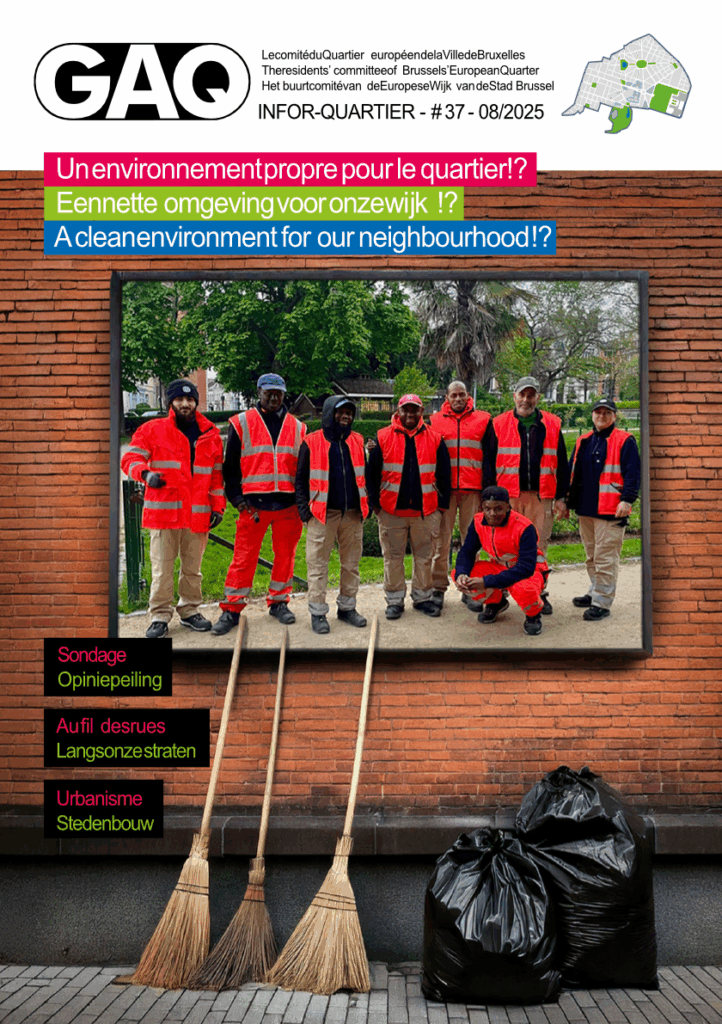
Table of contents
Click on a title to access the content.
Colophon
Editorial
GAQ: Our work
Poll: Cleanliness and the environment in the European Quarter
Let’s get to know the street cleaners
Interview with Councillor Anas Ben Abdelmoumen
Map: The air we breathe
A new life for the 2017 GAQ sensors project
What more can we do for a cleaner, safer Brussels?
Knowing the quality of your tap water
Autour de Marguerite, it’s also about cleanliness
Testimonial from a beautifier
Rats and crows in Brussels: coexisting with respect
News from our sister associations
Along our streets
Major urban planning files
A stroll through the old streets of our neighbourhoods
Europe in our neighbourhood: Gulliver in Lilliput?
GAQ’s traditional neighbourhood party and flea market
Colophon
Infor-Quartier 2025, edition 37
Infor-Quartier, annual newsletter of the GAQ, distributed for free in all mailboxes in the European Quarter of Brussels.
Printed in Belgium by Artoos
Graphics, last page and layout : Gero Sander
GAQ asbl,
Headquarters
rue Charles Quint 130
B-1000 Bruxelles
The GAQ’s governing body consists of seven members:

From left to right: Christian Dekeyser (Président), Nina Bachkatov, Chantal Matthys, Michael Van Gompen, Alain Dewez, Kristine De Mulder, Philippe de Boeck.
www.gaq.be
@GAQ_Bruxelles
Facebook GAQBruxelles
Publisher: Christian Dekeyser
Editor: Barbara Bentein
Editorial Board: Wouter Acke, Barbara Bentein, Philippe Deboeck, Hannes Frank, Chantal Matthys, Katia Vandenborre
Translation and proofreading: Wouter Acke, Danielle Beeldens, Jacques Boyer, Christian De Bock, Hannes Frank, Arabel Goldenson, Robert Nijhoff, Jonathon Sawdon
Photos and images: GAQ unless otherwise specified
Texts for Infor-Quartier 2025 were written in May-June for publication in August.
Editorial
The past year has been marked by various actions. Here are the most significant ones:
Urban planning, we participated in major cases for which appeals have been lodged, notably Newton, Cortenbergh 58 and The One (the latter has already been built and requires regularisation – which would set a precedent). The GAQ supports all these actions in various ways: support with correspondence, contacts with authorities, involvement in legal proceedings, etc.
Mobility, including the Schuman project, for which an appeal is still pending. Work on the roundabout has begun, and the central installation – the canopy – is likely to be abandoned. Promises of greening don’t seem to have been kept in this very hard-landscaping-heavy project. The diversion of bus and traffic to streets that are not suitable for so many and such heavy vehicles causes significant disruption. The GAQ is supporting local residents in their various proceedings.
Quality of life, notably the issue of noise and dirt caused by the renovation of the Shelton Hotel, which includes rooftop facilities and a terrace overlooking neighbouring houses. This was built without a permit. The GAQ monitored the situation and intervened.
Infor-Quartier, the latest edition which you are now reading, is the result of a wonderful collective effort. The articles were written by local residents. Infor-Quartier is the GAQ’s calling card.
The group “Fêtes” organises the neighbourhood party and the flea market. It also coordinates the GAQ’s participation in Winter Pop. The GAQ provides support for the increasingly popular street parties organised by local residents.
Let’s not forget our partnerships with BRAL and IEB, and our participation in the meetings of the Tervuren-Montgomery/Parc Léopold and Quartier des Arts committees. All of this cooperation creates a good vibe in the neighbourhood and yields results for the community.
Finally, we hope to continue hosting monthly meetings by inviting experts or politicians to speak on topics of interest to our members and friends. Please feel free to suggest topics and/or speakers for any of these meetings.
In memoriam Michel Van Roye, former GAQ administrator and former Councillor of the City of Brussels
Christian Dekeyser
GAQ – Your neighbourhood committee
Our mission is to bring people together, safeguard and improve the quality of life, preserve our heritage, raise awareness about global warming, and encourage citizen participation.
For more information about our work, have a look at the full online version of our magazine at www.gaq.be.
If you’re interested and you live in our neighbourhood, join us and become a member of GAQ! The annual fee is 25€, payable to the account provided below. Please include your name, address, and email in the transaction details. Join us and let’s make a difference to our community!
Compte/rekening/account: GAQ asbl – IBAN BE54 3631 8311 2697
Poll: Cleanliness and the environment in the European Quarter
Introduction
The cleanliness of our environment is something we feel very strongly about: our health depends on it, as do biodiversity and our quality of life. However, there are many challenges: despite our efforts, we are unable to keep our streets, squares and parks free of litter, tar and oil stains our roads, the air is too polluted by emissions and water is viewed with suspicion ever since we heard about PFAS. Effective waste management, reducing polluting emissions and protecting natural resources are priorities for us all. The GAQ is looking into this issue in our neighbourhood.
Results of the survey conducted by the GAQ
In spring 2025, the GAQ conducted a trilingual survey on cleanliness and the environment among residents and users of the European Quarter. The questions focused on cleanliness, public management, sorting of household waste, pavement maintenance, and air and water quality. By the time the survey closed on 5 June 2025, 100 people had responded.
Note: the comments in quotation marks do not necessarily reflect the GAQ’s position.
A dirty neighbourhood
Most residents are dissatisfied with the cleanliness of the neighbourhood, considering that ‘the neighbourhood remains generally dirty’ and even that ‘it is deteriorating week by week!’. Although they give an overall rating of 7 out of 10, they rate the cleanliness of the streets and pavements very negatively (4.9 and 3.8 out of 10 respectively). Opinions are mixed on green spaces (5.4), playgrounds (5.7) and sports fields (6). However, most criticise the waste collection system (6 out of 10).
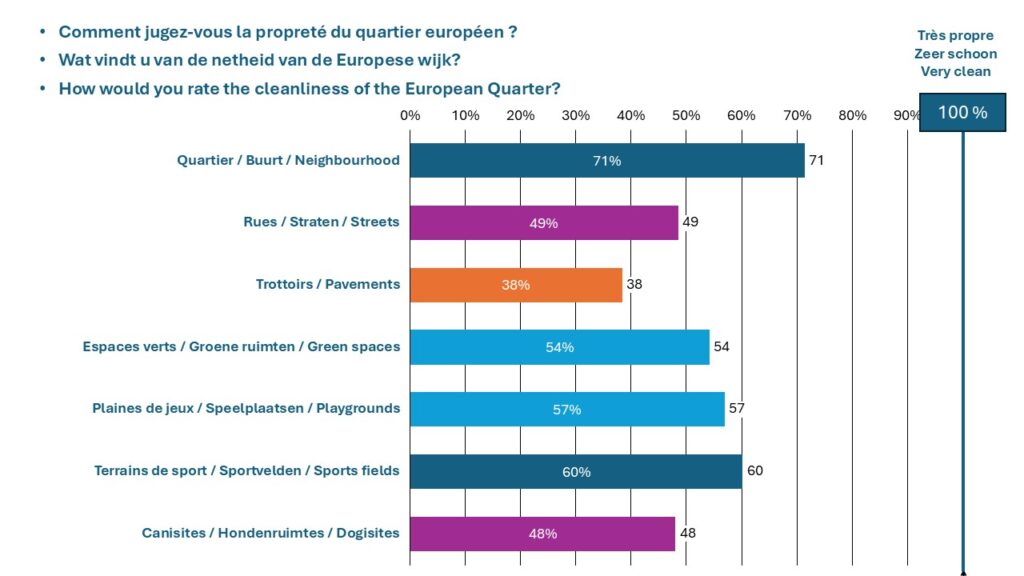
Public bins
When it comes to rubbish management, emptying public bins is the most critical issue according to respondents (3.9 out of 10). First and foremost, it is necessary to ‘replace all the street bins that have been removed’, ‘increase their number’ and ‘empty them more often, especially after festivities’, ‘especially between April and October’, and ‘also at weekends!’. These bins should be concentrated in ‘parks and green spaces or places with high footfall’, ‘at Ambiorix Square’, ‘at Marguerite Square’, ‘at the entrance to the Cinquantenaire Park on Renaissance Avenue’, ‘near bus stops and meeting points’. One person suggests opting for ‘a type of bin that compresses waste’.
Illegal dumping
The removal of public bins has not had the desired effect of limiting illegal dumping: ‘Illegal dumping happens anyhow!!!’. Survey participants call for monitoring and penalties: ‘Install cameras to identify illegal dumpers, who always come to the same place almost every week’ and ‘impose real penalties’.
Illegal dumping also raises the issue of waste collection centres, which should be ‘closer and accessible without a car’ and ‘open in the evenings and at weekends’. One solution would be to ‘be able to use the nearby Saint-Josse waste collection centre rather than the one in Buda, which is far away and difficult to access’. Another solution would be to have ‘bulky waste collections more regularly’.
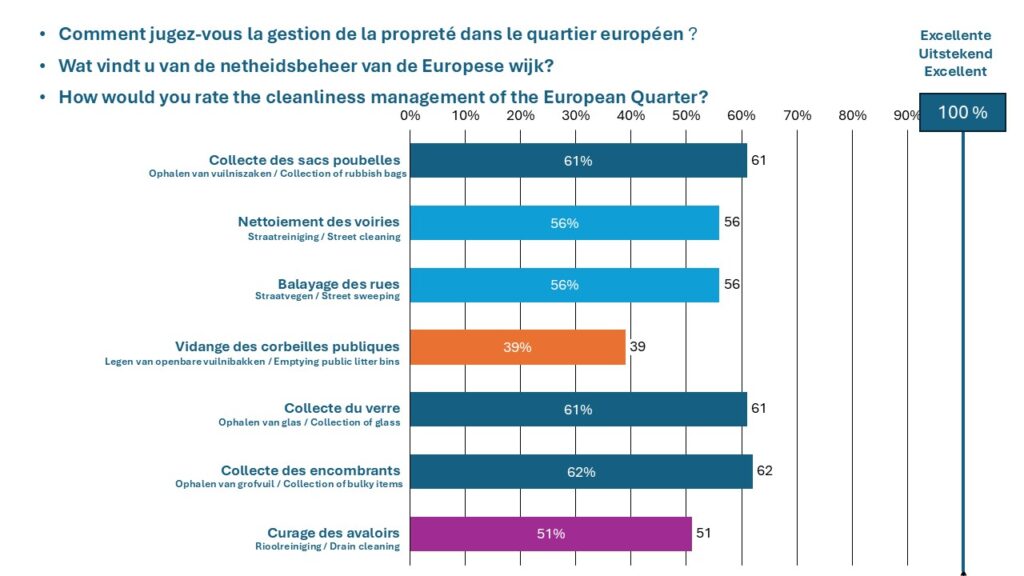
Waste bags
With a population of 18,864 (IBSA[1]), our neighbourhood produces a huge volume of rubbish bags, especially since the majority of people put out at least one white bag per week (79% of respondents). Some believe that it is ‘up to residents to consume reasonably and produce less waste’, particularly by ‘reducing home deliveries’. More structurally, it would be necessary to ‘ban or impose a deposit on disposables’ or ‘support local businesses for the recycling of items such as bread, clothing, books and paper’.
However, most blame the waste collection system (6 out of 10), which is sometimes described as ‘horrible’. Some call for it to be “streamlined” or even reformed and for ‘a better solution’ to be found, such as ‘containers at the end of the street’. The timetable is particularly problematic: ‘The deadline for putting out rubbish on Mondays between 6pm and 8pm forces people to stay at home or come home early from work. This deadline is ridiculous.’ ‘And as many neighbours come home from work outside these hours, a lot of people put their waste out late and many bags are not collected for a week.’
In any case, there is often a delay between when the rubbish bags are put out and when they are collected, which creates a mess: ‘Everyone leaves their rubbish bags on the street at any time of the week, which leads to additional waste deposits. This gives birds the opportunity to damage the bags and empty them by pecking at them, spreading the dirt.’
Dogs
‘There is a big problem with some dog owners and the mess they leave behind.’ It is certainly necessary to ‘raise awareness among dog owners,’ inform them of the rules (‘place clear and visible signs indicating the obligation to pick up dog excrement’) and encourage them to comply (for example, through ‘free distribution of dog bags’). But the problem is such that ‘owners must be punished more severely’: “1) fine dog owners who soil pavements and parks; 2) fine dog owners who allow their dogs to urinate on building façades. ”
The area around the dog park in Gutenberg Square is particularly affected: ‘Since it opened five years ago, there has been a dramatic increase in dog waste in our environment in Marie-Louise Square. The dog park itself, which used to be a beautiful green space, is now a muddy hole. It’s a disgrace!’
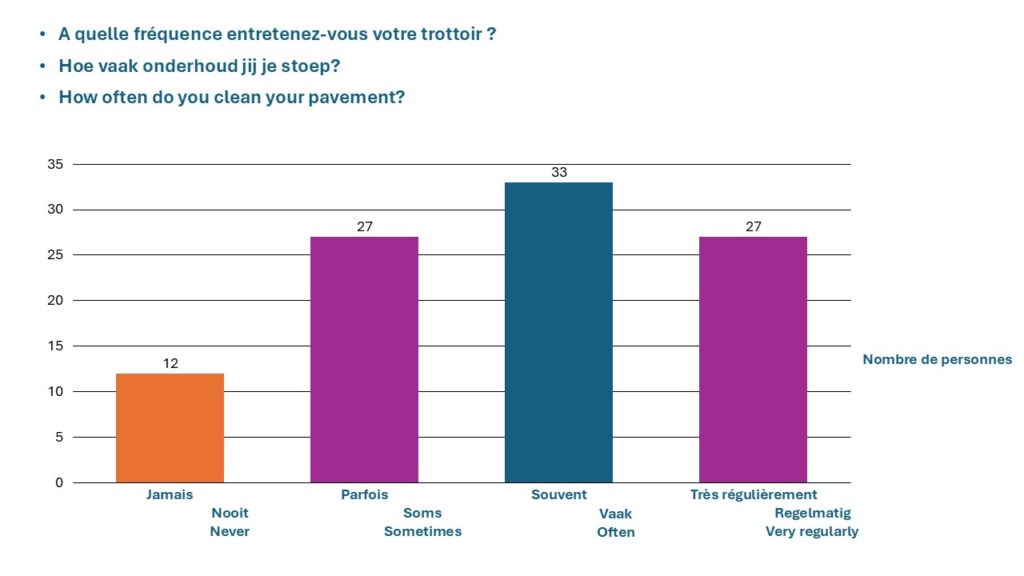
What can be done to improve cleanliness?
Informing and raising awareness are the top priorities. Given the ‘high tenant turnover’, it is necessary to ‘regularly inform residents about the rules for sorting and disposing of waste’, for example by means of ‘explanatory leaflets in a range of languages, not just French and Dutch’. Landlords could be required to indicate collection days, or campaigns could be launched in public spaces (at the foot of trees and on bus shelters, for example). In general, it would be necessary to ‘raise awareness among local residents of their responsibilities in terms of cleanliness (e.g. maintenance of pavements)’, targeting in particular ‘temporary residents’. This includes ‘young Eurocrat interns’, ‘shared houses’ and ‘construction workers who throw everything away indiscriminately on the day they leave’.
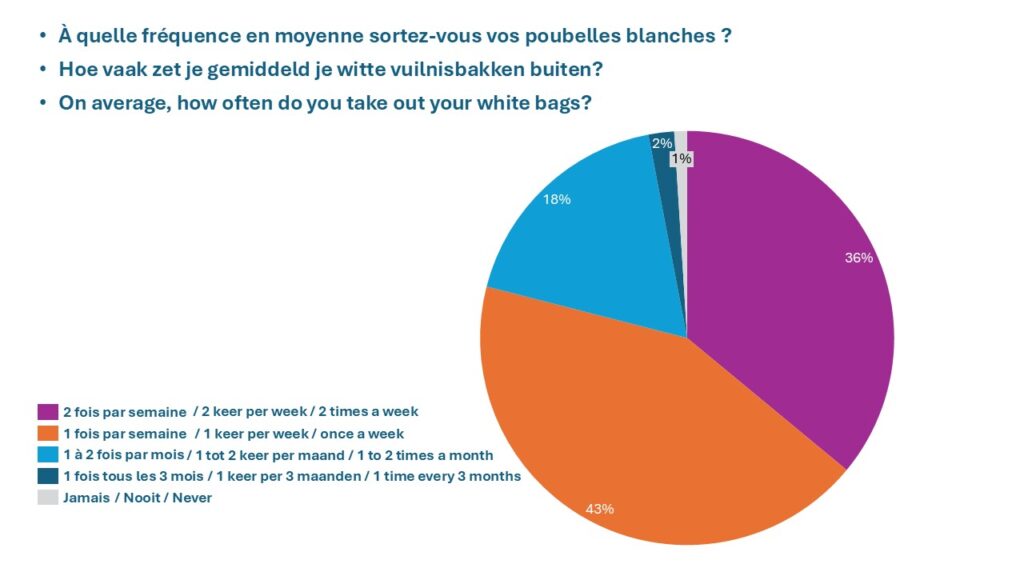
At the same time, there must be monitoring and sanctions. There should be ‘frequent inspections of the streets, even at night’, ‘surveillance of certain sites’ (by “camera”) and ‘a guard (supervisor) for the beautiful, busy squares’. There should be ‘increased checks and fines for cigarette butts, illegal dumping, spitting, dog poo, and waste bags left out at the wrong time’ or in the wrong place (‘filling public bins with waste that should be put in white bags’).
In general, there are calls to ‘enforce waste laws and fines’ and to ‘move towards stricter punishment for anti-social behaviour’: ‘issue fines for anti-social behaviour because it breeds intolerance and undermines “community spirit” in our beautiful, multicultural and peaceful neighbourhood’. Some point to ‘enormous shortcomings, particularly in terms of issuing fines’: ‘We often find that our authorities do not dare to issue fines […]. It is time to re-establish a framework and dare to issue fines, so that it is known and visible. From our point of view, our politicians have a responsibility to act’.
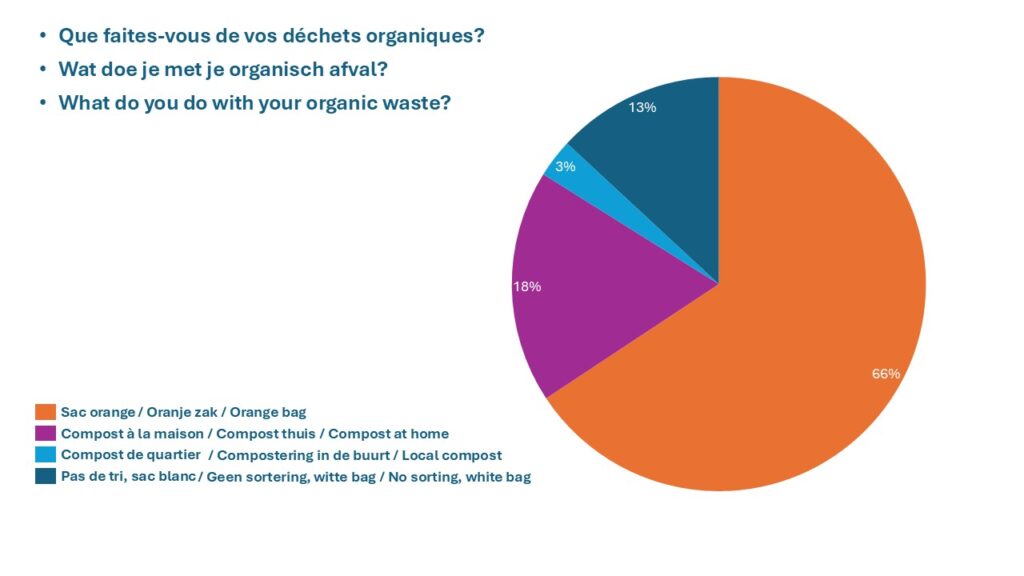
Residents are calling for fundamental measures: ‘tackling the causes, not just the symptoms’. They want the current management to be improved: ‘There is too much fly-tipping, abandoned waste bags and other minor incidents that are ONLY resolved after a complaint via FixMyStreet’. One of them even suggests ‘appointing a neighbourhood manager (someone who lives in the neighbourhood and acts as a link between the neighbourhood and the cleaning service)’.
What can be done to improve the environment?
Air quality is a major concern for residents, who rate it at 4 out of 10 and call for ‘a more sophisticated air quality monitoring system to be put in place’. It is therefore not surprising that 70% of suggestions for improving the environment in the neighbourhood focus on reducing road traffic: ‘drastically reduce the number of cars’, ‘fewer cars, especially diesel and petrol, fewer lorries, more electric buses’, ‘reduce the number of cars that have access to the neighbourhood’, etc.
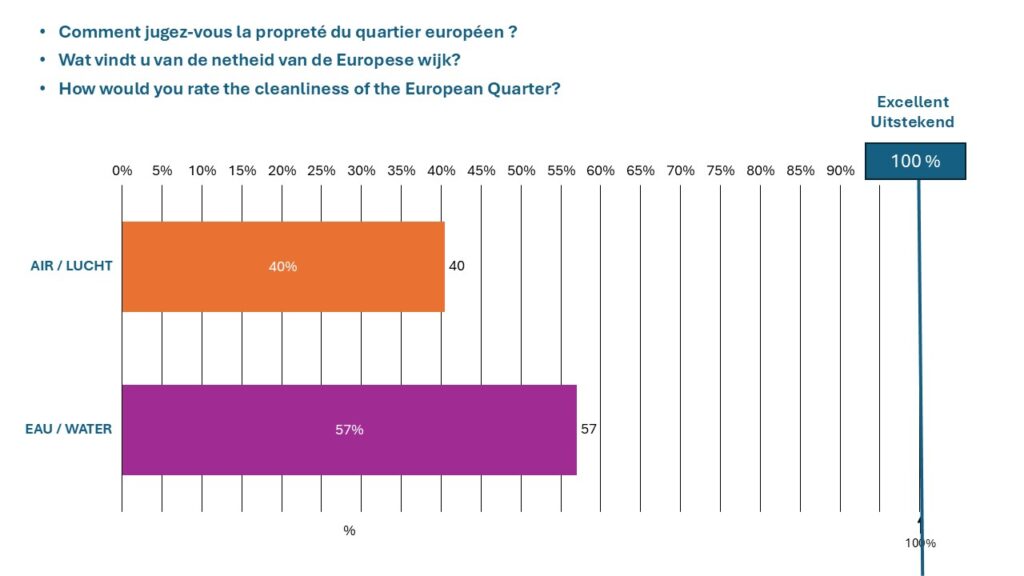
Transit traffic is the main target: ‘The constant traffic jams at the Schuman roundabout and Rue de la Loi are the main source of air pollution in the neighbourhood. It is truly regrettable that the regional government is not taking any initiative to limit this transit traffic in our neighbourhood.’ Several people point to the tax exemption for company cars, but the main focus is on ‘reducing the number of cars entering Brussels’, ‘carefully considering the E40 motorway access route’ and ‘reducing the number of commuters with the long-awaited RER’.
Several respondents complain about the ‘redevelopment of the Schuman roundabout’, which ‘has diverted traffic around Ambiorix Square, resulting in a deterioration in air quality’. ‘The work on the Schuman roundabout and the reduction in traffic lanes on Rue de la Loi deliberately sacrifice the lungs of several generations of local residents.’ In general, the traffic plan should be designed to limit non-residential traffic: ‘Stop non-residents from driving through our streets. The smell is sometimes nauseating in traffic jams.’ In addition, it is necessary to ‘avoid traffic jams in the neighbourhood streets’ and ‘better enforce speed limits’.
At the same time, soft mobility must be encouraged: ‘Encourage the use of bicycles and public transport by increasing the number of safe cycle paths and limiting car access in certain areas’. There should also be ‘more bicycle parking facilities and repair shops.’ In particular, ‘the use of bicycles should be promoted among European institution employees, who mainly come to work by car.’ One incentive could be to ‘organise more car-free days.’
At the same time, we must ‘continue to plant trees’: ‘more trees in the neighbourhood’, ‘more trees inside blocks’, ‘more trees on the streets and replace parking spaces with trees and green spaces’, ‘increase the number of green spaces’. And why not ‘green the Rue de la Loi to absorb fine particles’?
Analysis by Katia Vandenborre
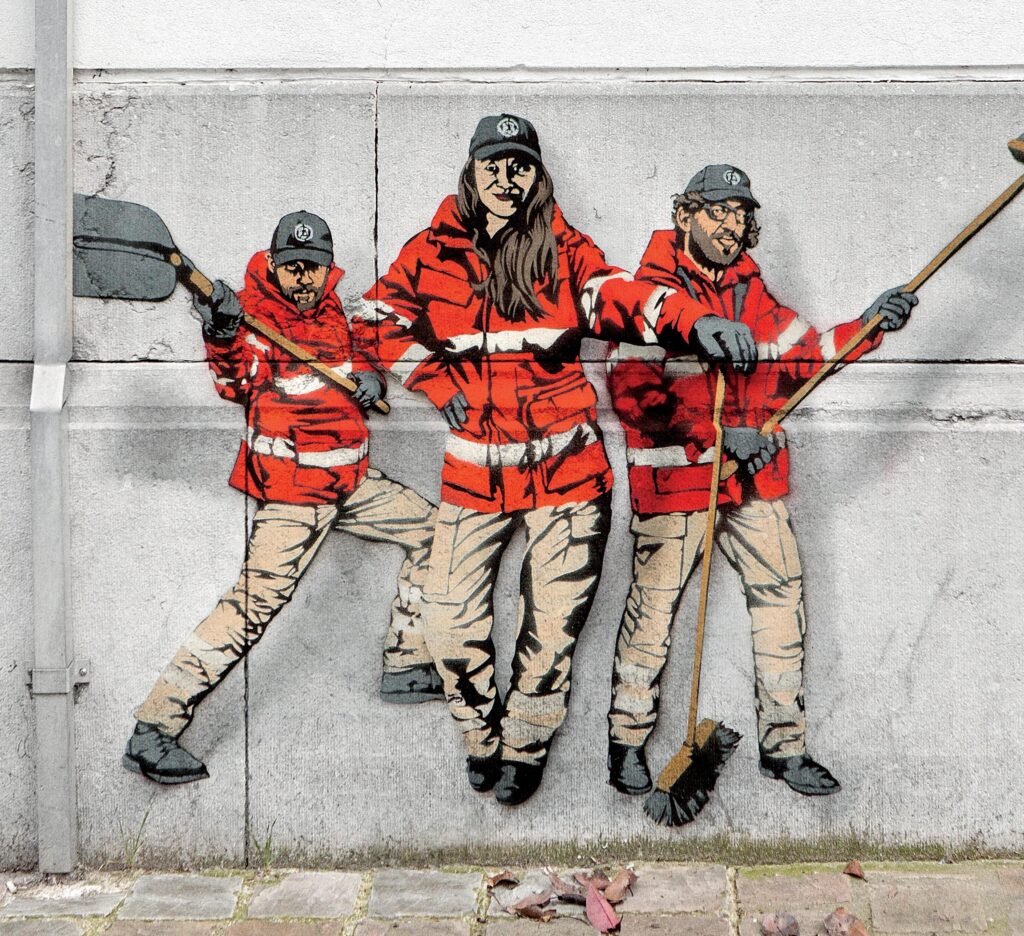
Let’s get to know the street cleaners
We see them every day on our streets, they are very visible in their orange uniforms and they provide us with valuable services, and yet… Do we know who these men and one woman are, who make our neighbourhood a little cleaner every day? The GAQ went to meet them and invites you to get to know them a little better. On 10 April, we had an appointment with Arnold, the team leader of the street sweepers.
The street sweepers get up very early to be ready at 6:30 am at their premises on Rue Jacques de Lalaing. Arnold himself comes every day from Aalst by train. At 6:40 am, they go to the ‘Cap.’ This is the enclosure on Ambiorix Square where the street cleaners store most of their equipment. From there, everyone goes to their ‘post.’ Before leaving, Arnold will have distributed the nine posts among the 12 members of his team. Then the team gets to work. At 2:00 pm, their work is finished and the street cleaners meet at the premises to take a shower and go home at 2:30 pm.
It should be noted that not all 12 members of the team are always present due to leave or illness.
GAQ: What does the job involve?
Arnold: At seven of the twelve locations, the job will be to sweep the streets. At the other two stations, the job is to remove waste from bins and illegal dumping sites. And this work is done come rain, wind, frost or heatwave. The sweepers work and pick up what our negligence or carelessness has caused to fall on the ground. To do this, they all have a trolley, a broom, a shovel and a tool for opening manholes. Because yes, street sweepers also ensure that our gutters flow properly.
GAQ: What else do you do?
Arnold: We have two robot sweepers, machines that travel along our streets and pavements to clean the road surface and collect leaves and fruit from trees that could clog the drains.
GAQ: Can you tell us more about illegal dumping and the waste bags that some residents put on the pavement outside the designated times?
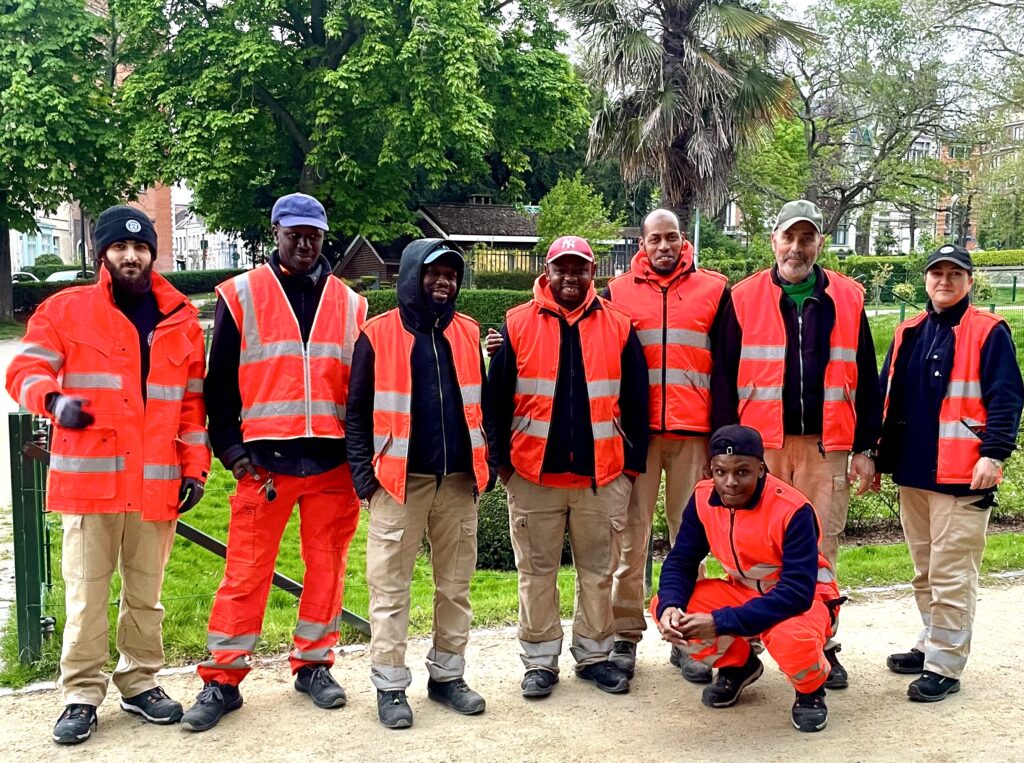
Arnold: Every day, I check out the ‘hot spots.’ The street cleaners know the places in the neighbourhood where bulk waste is often dumped: Rue de Gravelines, Rue du Carrousel, Rue Charles Quint, Rue du Noyer, Rue Franklin, all places where fellow citizens (sometimes from Schaerbeek or other municipalities, because they don’t want to litter their own neighbourhood) come to dump all sorts of things. This is despite all the services offered by the City to enable residents to dispose of their bulky items: home collection and ‘Bulky Item’ days organised twice a year.
GAQ: There are often discussions about street bins. Some people want more, others want fewer. What do the street cleaners think?
Arnold: There need to be enough bins in key locations. It’s true that some residents put all their household waste in them, and then they overflow. Street cleaners empty these bins twice a day into green bags, which are then collected. There is a significant lack of information and awareness among the public, despite the distribution of flyers and information packs for new arrivals. We need very graphic, easy-to-understand posters.
The GAQ could invite the street cleaners to attend the annual flea market at Square Ambiorix in September, not to sweep, but to talk to residents about their work.
GAQ: What about fines for anti-social behaviour?
Arnold: When residents report that someone is repeatedly putting out their waste bags outside the designated days and times, or that someone is illegally dumping waste, the street sweepers’ team leader goes to the site to check. He can then call in a mediator to talk to the people concerned. If that doesn’t solve the problem, a fine will be issued. Unfortunately, we end up issuing fines to around 20 people every month. It’s a real shame.
GAQ: Do you have a message for our residents?
Arnold: Keeping the neighbourhood clean is everyone’s responsibility. We do our bit every morning by sweeping and removing waste. We leave you with a clean neighbourhood. After 2 pm, we are no longer there. We could ask you to keep the neighbourhood clean. But at least when things get dirty after we’ve been there and you report it to us, please be courteous.
GAQ: We understand that the messages Arnold receives are not always very polite. Thank you very much! Your work is greatly appreciated by those living in our neighbourhood!
Had enough laughs?
Have you noticed them yet? Next to rubbish bins or lying around on the ground? Heavy metal cylinders, brightly coloured, sometimes left behind in a cardboard box? They are nitrous oxide cylinders, which end up being dumped when empty.
Officially, they are used to inflate balloons or make whipped cream, but in reality, they are drugs. Users inhale it through a balloon and get high. It is the same product that dentists use as an anaesthetic. Since last year, the improper use of laughing gas, i.e. as an intoxicant, has been banned in Belgium. But as with many laws here, compliance is limited. The health risks, although lower than those associated with crack and heroin use, are nevertheless significant, especially with repeated use. And it does create a waste problem for us.
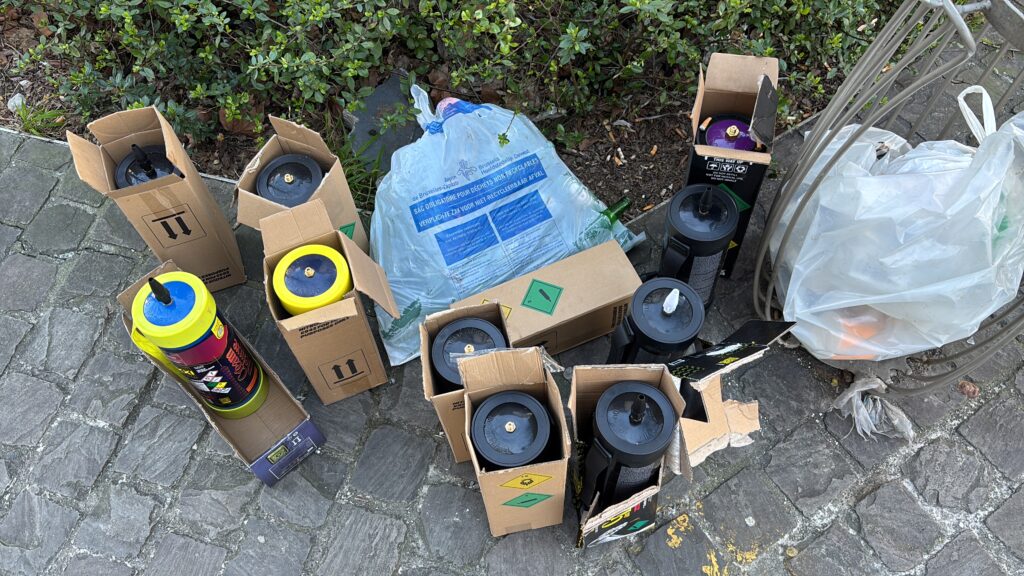
What is the problem?
The problem is that incinerators can’t handle these cylinders. They explode in the oven, damaging it internally. The oven must then be shut down for inspection or repair, and that all costs money. Almost €10 million per year. No small matter for our impoverished region.
If you know where to look, you can find them everywhere. The ban clearly isn’t helping. Maybe we should just be a bit more practical? Last year, around 30,000 nitrous oxide canisters were dumped in Brussels. Together, they weigh 150 tonnes, which is millions of doses.
What if we paid a few euros’ deposit per bottle to those who take them to a recycling centre? That would cost a few hundred thousand euros. A fraction of the damage currently being done to our incinerators, which runs into millions.
Our region is reluctant to do this because it would be subsidising drug use. But is it any different from the injection rooms and free needles we offer to users?
Wouter Acke
Interview with Councillor Anas Ben Abdelmoumen, responsible for public cleanliness

GAQ: Councillor, you have just visited the European Quarter of the City of Brussels. How would you assess the situation in terms of cleanliness?
ABA: Generally speaking, the situation in the European Quarter is quite satisfactory. Your cleaning initiatives, such as “Embellisseurs de la Ville” (City Embellishers or Beautifiers), undoubtedly contribute to this, and I would like to thank you warmly for that. Ensuring clean public spaces is obviously a daily and tedious task, and this neighbourhood also has challenges that we must address. I’m thinking, for example, of rubbish bags that are not always put out at the right time or illegal dumping at the foot of trees. On some café terraces, too many cigarette butts also end up on the public highway. We have sent a mediator from our cleanliness department to these cafés to find a suitable solution with those running them. The European Quarter is also home to many expatriates who often only stay in Brussels temporarily, but it is of course essential that they too understand and respect the rules on public cleanliness. That is why we want to use more pictograms in our flyers, for example.
‘Thank you for highlighting the remarkable work of our field agents, who carry out an essential mission every day, one that is all too often overlooked.’
GAQ: Despite the remarkable efforts of the men, and the only woman, who sweep our streets and organise ‘bulky waste’ collection days, we unfortunately still often see illegal dumping. How do you plan to address this problem? What can we do as citizens?
ABA: Thank you for highlighting the remarkable work of our field agents, who carry out an essential mission every day that is all too often overlooked. With regard to illegal dumping, our approach is structured in several stages. First, awareness-raising is carried out when there is no known history at the address in question, whether for an individual or an entity. If the situation persists or in the event of serious offences, we issue fines, sometimes with the support of the police in joint operations. We also encourage citizen involvement through the Fix My Street app, which allows users to quickly report any cleanliness issues or other problems. Each report triggers a targeted response: awareness-raising, investigation to identify the perpetrators, or fines issued by our officers. Because the cleanliness of public spaces is a common good, only collective action — involving citizens, municipal services and the police — will enable us to combat illegal dumping effectively .
GAQ: There are differing opinions about street bins, with some considering them essential and others seeing them as magnets for illegal dumping. What will your policy be? How will local residents be involved in the decision-making process?
ABA: My policy on public rubbish bins is guided by pragmatism. There is political agreement on the return of rubbish bins, but this decision must be made objectively, taking into account specific criteria. Rubbish bins will be installed where they are needed, taking into account the specific needs of each area. Each request for installation or removal will be carefully analysed, whether it comes from residents or our field teams, who know the neighbourhoods well and guide us in our decisions. Although the voice of local residents is crucial, their opinions sometimes differ, which is why we make decisions based on everyone’s feedback and the objective findings of our teams.
As for our general policy, it favours the installation of bins in strategic locations: near public benches, around schools, public transport stops and in busy shopping areas, in order to meet the most obvious needs.
GAQ: In recent years, a new scourge has emerged: laughing gas cylinders. They litter our streets and are dangerous. What can be done?
ABA: Indeed, nitrous oxide, like all other drugs, is particularly dangerous to our health. In addition, these laughing gas cylinders pollute public spaces. Every year, our services have to remove dozens of tonnes of these cylinders abandoned in the streets, squares and parks. They contain extremely dangerous substances, which makes their disposal far from straightforward. Research shows that young people still do not perceive nitrous oxide as a dangerous or risky substance for their health. More effective and targeted awareness-raising is therefore needed to change this perception. In addition, the ban on the recreational use of nitrous oxide must be better enforced and producers must be held accountable.
GAQ: In February 2023, the City of Brussels adopted a motion to introduce a deposit on PET bottles and cans. It also became a member of the Alliance for Deposits. At least two-thirds of citizens are in favour of this. How do you intend to translate this commitment into reality?
ABA: Together with the City of Brussels, we are strongly in favour of a deposit system for cans and PET bottles, as it is an effective tool in our fight against pollution in public spaces. Abroad, deposits have already reduced the amount of beverage packaging abandoned in public spaces by 90%. That is why we are delighted that a decision has been taken at European level for all EU countries to introduce such a deposit system by 2029. In our country, this falls within the remit of the regions. Together with the City, we will therefore continue to urge the Region to implement this deposit system as soon as possible.
GAQ: Cleanliness also means clean air. Air pollution is responsible for nearly 1,000 premature deaths in Brussels every year. Our neighbourhood, like other neighbourhoods in the City of Brussels, is not doing well in terms of nitrogen and PM10 fine particle concentrations in particular (although for PM10, the limit value of 20µg/m³ proposed for 2030 is respected at all measuring stations in Brussels, this is not the case for the annual value recommended by the WHO of 15 µg/m³, which is systematically exceeded). And in relation to these issues, we are not hearing good news from the City of Brussels (LEZ policy). What message do you have for the many people suffering from respiratory, allergic, and circulatory problems, living in such a polluted environment?
ABA: The City of Brussels is fully aware of the impact of air pollution on the health of its residents, particularly the most vulnerable suffering from respiratory, allergic or circulatory conditions. To address this issue, several concrete actions are being implemented or developed under the leadership of my colleague, Mr Frederik Ceulemans, the Deputy Mayor for Climate. For example, the City is working on installing additional sensors to better assess the situation in all neighbourhoods and ensure an equitable distribution of measuring tools across the territory. In addition, the City is currently developing an online mapping tool to monitor air quality in real time, and there are plans to use information screens to alert residents when pollution peaks. Finally, measurement campaigns are planned in sensitive municipal buildings (schools, nurseries, retirement homes, etc.) to assess indoor air quality and make concrete improvements.
GAQ: As all these issues are rightly seen as very important by residents, how do you intend to maintain a dialogue that will help to ease frustration and celebrate progress?
ABA: You can only implement a good cleanliness policy if you are in tune with the cleanliness challenges in each neighbourhood. That is why I attach great importance to dialogue with our residents, shopkeepers, associations and businesses. I am a hands-on person. If you have any questions or would like to make an appointment, please don’t hesitate to contact me at cabinet.a.benabdelmoumen@brucity.be, by phone on 02 279 52 00 or via my social media accounts. As of this year, I will be bringing back the Cleanliness Committees, where I will visit different neighbourhoods of the city with my teams regularly, talking to residents about the cleanliness challenges in their neighbourhood and working together to find appropriate solutions.
Map: The air we breathe
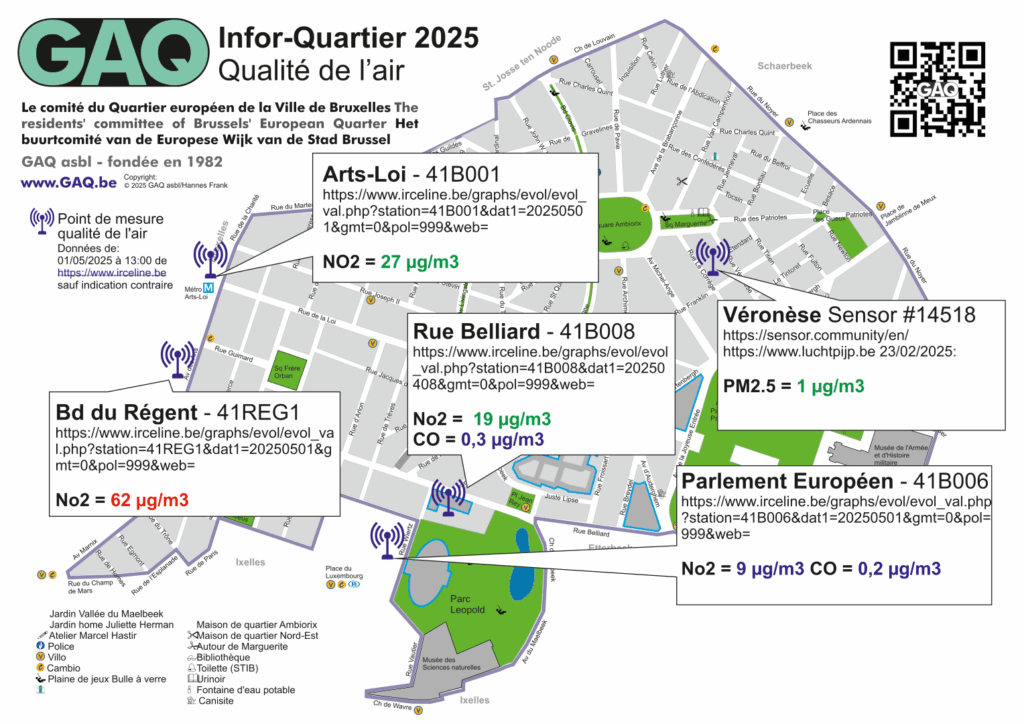
Air pollution has been called an “invisible health threat”[2] (1) and “the most important environmental health risk factor in Europe”(2). Air pollution is directly linked to heart and lung disease, strokes and lung cancer. In 2018 unhealthy air was estimated to be responsible for over 500,000 premature deaths in Europe every year (3). In Brussels, every year 930 people die before their time due to air pollution (4). This means more than two deaths per day, and more than 10% of all deaths in the Belgian capital are caused by air pollution.
In 2024 almost half of the cases of invalidity (serious illness/health problems) were caused by respiratory or lung diseases (5).
Have we scared you? In this case, being scared is smart, becoming active even more so because our little quarter at the heart of Europe is no exception! Eight years ago, in the article “La pollution de l’air” in Infor-Quartier 2017, we described our quest for valid information about the air quality in our neighbourhood, lamenting the scarcity of sensors and valid data. We demanded more high-quality measuring stations, transparent data and maps, and, above all, effective measures to improve the air quality where we live in the heart of Europe.
The air in our quarter
Regrettably, much of the data relevant to our area is out of date. In spring 2025, we could identify only four “official” stations in our area, of which only the one on boulevard du Régent measures the notorious PM (Particulate Matter) – fine dust particles. They are located at: Arts-Loi – 41B001 – measures only NO2 ; European Parliament – 41B006 – only CO; C6H6 ; Rue Belliard – 41B008 – only NO2 ; Bd du Régent – 41REG1 – NO2; PM10; PM2.5.
One “unofficial” station in rue Véronèse provides only PM2.5 values. It is part of the Sensor Community (https://sensor.community/en more on this later), which also has some stations in surrounding areas. The exact position of sensors is vital for understanding their values. This is because sensors along the street and at street level give values relevant for pedestrians and cyclists, while sensors on a roof or in a garden are more of general or academic interest.
Instead of charts and figures, we have collected data relevant to our area in this year’s Infor-Quartier centrefold map. If you want to keep current, detailed data in your pocket, we have referenced a few mobile device apps in our list below.
We don’t have much industry in our area, so where does the pollution come from? According to research published by the VUB and ULB, these emissions come from several different sources:
- NOx (also known as NO2) Nitrogen dioxide emissions in Brussels are mainly from cars, other road transport (47%) and building heating. And a significant proportion (40%) seems to be from emissions outside the Brussels region. This pollutant remains the main type of air pollution in the Brussels region.
- PM10 is fine particulate pollution from building heating in the residential and service sectors in Brussels, including financial, educational, and hospitality services. It was the main local source of PM10 pollution, causing 55% of direct emissions. Road transport was estimated to account for 42% of emissions.
- PM5 levels come from a combination of local (20%), regional (35%) and background pollution (45%).
A new life for the 2017 GAQ sensors project
Unfortunately, our 2017 project for a network of sensors in our quarter did not develop as hoped. But now, with renewed energy, a more desperate situation, and new technical options available, we will take the initiative to set up one or more stations in our streets. The aim is to provide officially recognized data that will be integrated into official maps, highlighting the local situation and putting pressure on the responsible authorities to take action.
We are currently checking our options to find professional sensors providing valid and sufficient data (PM2.5; PM10; O3; NO2 …). These should contribute to a solid, future-proof initiative, with our data displayed in officially-recognized maps and charts (no island solution). The data will be visible in real-time on the GAQ site to help us plan our day. If you are interested, please come to one of the monthly GAQ meetings; we will also keep GAQ members updated in our newsletter.
Do you remember CurieuzenAir?
This participatory science project was carried out in Brussels at the end of 2021 to measure air quality throughout the Brussels-Capital Region.
3,000 Brussels residents, individuals, schools and businesses installed a measuring kit on their façade to record nitrogen dioxide concentration (a good indicator of pollution from road traffic) in their street.
The project shows a relative improvement in air quality in Brussels in recent years. And our neighbourhood didn’t fare too badly: phew, we can breathe!
CurieuzenAir was supported by the University of Antwerp, the ULB, the BRAL citizens’ movement, Bruxelles Environnement and several media partners.
What else can we do for a cleaner, safer Brussels?
Hello neighbors!
Have you ever wished our streets and schools felt safer and the air fresher? Many citizens in Brussels are making that vision a reality with projects that bring us closer together.
One good example is Rues Scolaires/Schoolstraten where streets near schools are closed to traffic during busy drop-off and pick-up times, or even for the whole school day. This creates a safe, car-free zone where children can walk, play, learn and breathe cleaner air (more info: https://www.bruxelles.be/quartiers-scolaires)
Another inspiring initiative is Heroes for Zero. Their mission is big yet simple: to have zero road fatalities and serious injuries in our city. Through local events and campaigns, they spread the word about road safety and a healthier, less polluted environment.
Also, Filter Café Filtré is a friendly local group bringing residents together by organizing workshops and events aimed at rethinking our neighborhood spaces. With input from parents, children, and community members, Filter Café Filtré promotes more car-free zones and creative ideas to improve our air quality and public spaces.
Small, community-driven actions can lead to big changes. If you’d like to join these efforts, share ideas and work together for a healthier Brussels, contact ca@gaq.be or ecf.rrr@gmail.com . Every step counts towards a better future for us all!
Randy Rzewnicki
98% of us breathe (very) polluted air
Air pollution in Brussels is not only an environmental problem, but also a matter of social inequality. BRAL’s ExpAIR project shows that 98% of Brussels residents breathe air that does not meet World Health Organization (WHO) standards.
It is striking that air pollution is unevenly distributed over the city. In the area between ring-roads R20 & R21, where car ownership is lower and people live closer together, the air quality is actually worse. This is because pollutants accumulate in densely built-in areas, where they find it difficult to escape. Tall buildings and a lack of green space reinforce this effect.
This situation mainly affects vulnerable groups, who often have less access to clean air and green spaces. The ExpAIR project aims to create awareness and involve people in the measurement and improvement of air quality in Brussels. By working together, we can strive for a healthier and fairer city for everyone.
Are electric cars the answer?
Electric cars might seem like a cleaner option, but they actually increase some types of air pollution. Brake pads, tires and road wear produce particles that harm our health. The most dangerous particles are tiny, less than 2.5 microns in diameter (PM2.5). They enter our lungs and cause serious health problems like heart disease, strokes, lung disease, and cancer.
A whopping 60% of road-traffic particles smaller than 10 microns are not from burning fuel but from tires, brake pads, and road wear. One study found that brake-pad dust damages human lung cells more than diesel fume particles. Why? Because brake pads have higher copper levels, which can damage cells and DNA.
Electric vehicles produce more non-exhaust particles than other cars because they accelerate more quickly and have heavy batteries. One study showed the average weight of an electric car was 2,133kg, whereas regular cars weighed 1,500 – 1,800kg.
The good news: despite their drawbacks, electric vehicles are still cleaner than other cars. Fumes from cars are harmful to our health and smaller cars are better. Big cars are dangerous and most people don’t need the extra range from big car batteries. It’s important that electric vehicles use clean electricity, because burning coal or gas for power just moves the pollution from the exhaust to the power plant chimney. Electric cars are important for the energy transition, but they’re not THE answer.
Knowing the quality of your tap water
Did you know that you can find out about the quality of the tap water in your street by visiting the Vivaqua website?

VIVAQUA is a 100% publicly owned company that ensures that drinking water reaches the taps of consumers in Brussels every day.
In our neighbourhood, as everywhere else in Brussels, tap water is excellent drinking water. Vivaqua publishes monthly reports on its website analysing the quality of the water, including results relating to PFAS. Since the end of 2021, Vivaqua has been systematically and regularly monitoring PFAS levels at its collection sites, particularly its six reservoirs that supply the Brussels Region.
More info: https://www.vivaqua.be/fr/qualite-de-leau/
Autour de Marguerite is about cleanliness too
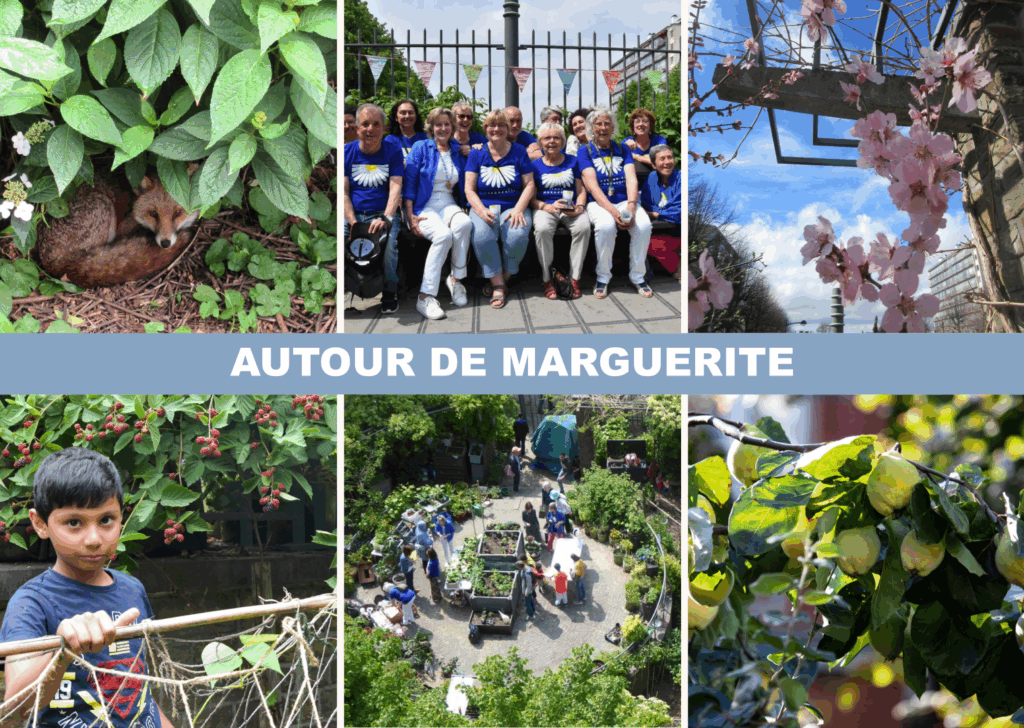
Between 2012 and 2018, the Councillor in charge of cleanliness organised citizen meetings in all neighbourhoods of the city. She was also behind the creation of the “Ambassadors of Cleanliness”. Her successor took up the concept thereafter and the “Ambassadors” became “Embellisseurs” (Beautifiers) to highlight their additional role in promoting “nature in the city”.
The project does not seem to have been very successful. In our experience, this is partly due to a lack of follow-up by the councillor and her office. For example, we never received any responses to our questions and suggestions for improvement.
In general, there was little engagement on social media (which is just as well, as we were not in favour of it for ethical reasons) and little interaction between residents, the councillor’s office and her administration.
This did not prevent a few neighbours from continuing to look after the quality of life in the neighbourhood in “splendid isolation”!
Let’s be fair: Place des Gueux, for example, has been renovated, resulting in a significant reduction in litter and illegal dumping. It’s a shame that this work did not include “demineralisation”.
In terms of greening, there have been notable improvements over the last six years.
Two examples are the renovation of certain intersections with the planting of trees and the possibility for local residents to adopt tree bases, which helps to protect them from “aggression” caused by regular rubbish bag dumping.
In short, the results are mixed on the one hand but more encouraging on the other.
Autour de Marguerite
Testimonial from a beautifier
We asked a neighbour involved in the fight against anti-social behaviour a few questions
IQ: Why did you get involved in promoting public cleanliness?
CDB: It was based on a very simple line of reasoning: in addition to what the municipality or the Region can do for me, I also feel responsible for what I can do for them, i.e. for my immediate environment, my neighbourhood and my neighbours. As an Embellisseur, I devote one or two hours a week to public cleanliness.
IQ: What do you actually do in the field?
CDB: Like many Brussels citizens, I regularly report issues via the FixMyStreet app. I don’t keep a systematic record, but unfortunately it amounts to several reports a week.
Every Sunday, I walk around Square Marguerite picking up small items of rubbish. The “harvest” varies from week to week depending on the season and the weather, but it is – unfortunately – always fruitful.
I have also “adopted” half of Rue Jenneval, between the square and Rue des Confédérés, as well as the glass recycling bins on the same street, which many people confuse with an OlioBox.
IQ: That sounds like the normal job of our street cleaners. Do you think their work is inadequate?
CDB: On the contrary, my action is a way of paying tribute to their hard work. Don’t forget that they start their day very early, rain or shine, wind or snow (rarely!).
It’s the inconsiderate passers-by who upset me. But I don’t go so far as to point out their lack of manners when I catch them in the act.
IQ: Any anecdotes to finish with?
CDB: One day, in Square Ambiorix, I saw a man finishing a can of drink and throwing it on the ground a metre away from a green bin.
I caught up with him and asked him if I could throw his can in the bin. What do you think his reaction was?
IQ: He pretended not to understand, quickened his pace to get away from you, understood the irony of your question and threatened you?
CDB: Not at all, he just said “OK”, so he graciously allowed me to dispose of his rubbish! I still laugh when I think about it, it’s better than crying.
That said, I encourage Infor-Quartier readers to follow my example and thank them in advance. Even contributing occasionally to everyone’s well-being is very rewarding!
Interview by Autour de Marguerite
Rats and crows in Brussels: coexisting with respect
In Brussels, as in many large cities, certain animal species adapt very well to the urban environment. This is the case for rats and crows. Often unpopular, they are nevertheless full-fledged inhabitants of our city. Their presence challenges us to reflect on our habits, and especially on how we manage waste.
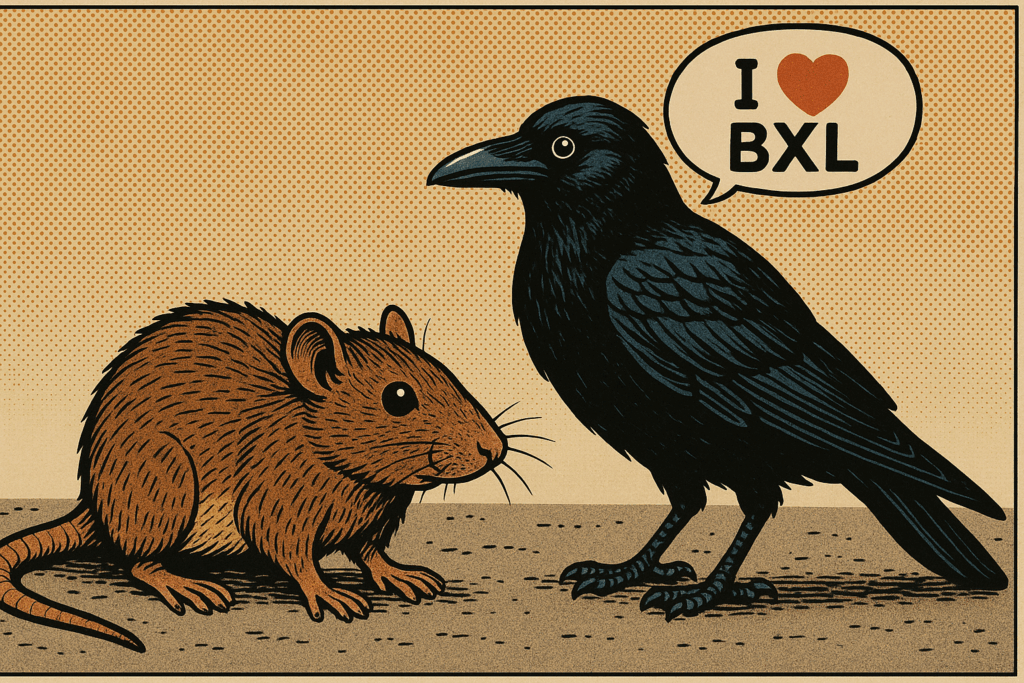
Intelligent and useful animals
Rats are highly intelligent and social rodents. They live in organised groups and play a role in the urban ecosystem, particularly by cleaning up certain types of organic waste. Black crows, on the other hand, are extremely intelligent birds, capable of using tools, solving complex problems and adapting quickly to their environment. They feed on insects, food scraps and sometimes even small rodents.
Contrary to popular belief, neither rats nor crows seek to harm humans. They simply live where they can find food and reproduce.
Why are their numbers increasing?
The main reason for the proliferation of rats and crows is easy access to food. In Brussels, poorly packaged food waste, thrown onto public roads or left outside collection times, creates a veritable ‘all-you-can-eat buffet’ for these animals. The more food there is, the faster they reproduce. Female rats can have several litters per year. For crows, access to abundant resources allows them to successfully raise more young.
Another factor contributing to the increase in crow populations is direct feeding by humans. Although often well-intentioned, this practice disrupts the natural balance and promotes overpopulation. It is therefore essential to raise public awareness of the importance of not feeding crows and to implement educational campaigns to prevent this habit.
In the case of rats, recent studies conducted in 16 cities around the world (including Amsterdam, New York and Toronto) show that global warming also plays an important role in the increase in rat populations.
Human activities are therefore largely responsible for the proliferation of certain animal species in our cities.
What can be done?
Rather than trying to eliminate these species, which is often cruel and ineffective in the long term, we can adopt humane and responsible solutions:
• Manage our waste properly: use orange bins for organic waste (orange containers are available free of charge from the City), respect collection schedules, and avoid leaving food scraps on public roads or in parks. Above all, it is a question of civic responsibility.
• Raise awareness in the neighbourhood: the more of us who adopt good practices, the more visible the effect will be.
• Adapt public spaces: closed bins, well-maintained compost bins and secure storage areas can reduce accessible food sources.
• Observe with kindness: these animals are a reflection of our way of life. By understanding them better, we can also better understand our environment.
A city to share
Rats and crows are not enemies: they are cohabitants. However, their growing numbers are a sign: they remind us that the city is an ecosystem and that our actions determine the balance between different animal species. Rather than demonising them and seeking to eliminate species that we now consider ‘pests’, let’s learn to adapt our behaviour.
By changing our habits, we can reduce nuisances (no one likes a dirty city), while recognising the legitimate place of these animals in our urban ecosystem.
The dangers of rodenticides and more humane alternatives
Rodenticides, commonly used to control rat populations, work by causing internal bleeding in rodents, resulting in a slow and painful death. In addition, these poisons pose a danger to other animals, particularly the natural predators of rats such as birds of prey, which can be poisoned by consuming contaminated rats.
In light of these risks, more humane and environmentally friendly alternatives are being explored. For example, in Brussels, contraception programmes for pigeons have been successfully implemented.
Similarly, New York City recently adopted a similar approach for rats by introducing specific contraceptives. In September 2024, the city of New York (https://abcnews.go.com/US/rat-birth-control-rat-walks-new-initiatives-curb/story?id=117620322) adopted ‘Flaco’s Law,’ allowing the distribution of rat contraceptives in specific areas. These contraceptives, such as ContraPest, reduce the fertility of rats without killing them, offering a more ethical and sustainable solution. Initial results are promising, with a significant decrease in rat sightings in the targeted areas.
These initiatives show that it is possible to manage urban animal populations in a respectful and effective manner, favouring methods that preserve the balance of our urban ecosystem.
Elena Nalon
News from our sister associations
Autour de Marguerite: Long live the Pipistrelles
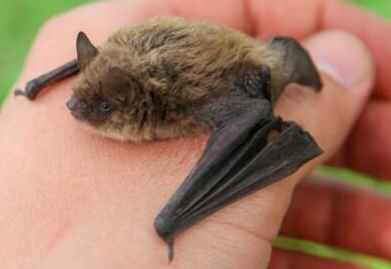
The residents’ collective “Autour de Marguerite” organized a fundraiser to install bat shelters in public spaces as well as in private homes.
Despite their sometimes negative reputation, bats are harmless and play an essential ecological role because they feed in large quantities on insects such as mosquitoes. Each shelter costs approximately €50. The collective raised over €1,000 and received a promise of in-kind contributions from the City of Brussels. In autumn, we will organize the collective installation of the shelters. Thank you very much for your valuable contribution!
L’Estampille brings books and reading to life!
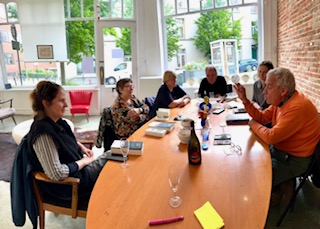
L’Estampille, a cultural promotion space at 75 Rue de Pavie, is once again committed this year to encouraging the pleasure of reading in all its forms.
Thanks to its book box installed in front of the gallery, neighborhood residents can freely drop off, borrow, or simply discover a book. This small exchange point has become a vibrant space where stories travel from hand to hand.
Every week, members of L’Estampille also visit the Éburons preschool to lead reading sessions with the children. A gentle and joyful way to awaken their imagination from a young age.
Finally, this year, a reading circle has been established, meeting once a quarter. Around two selected books, participants share their impressions and thoughts in a spirit of openness and conviviality.
Would you like to learn more or participate? Write to: info@estampille.be
Along our streets
Rainwater, a precious resource!
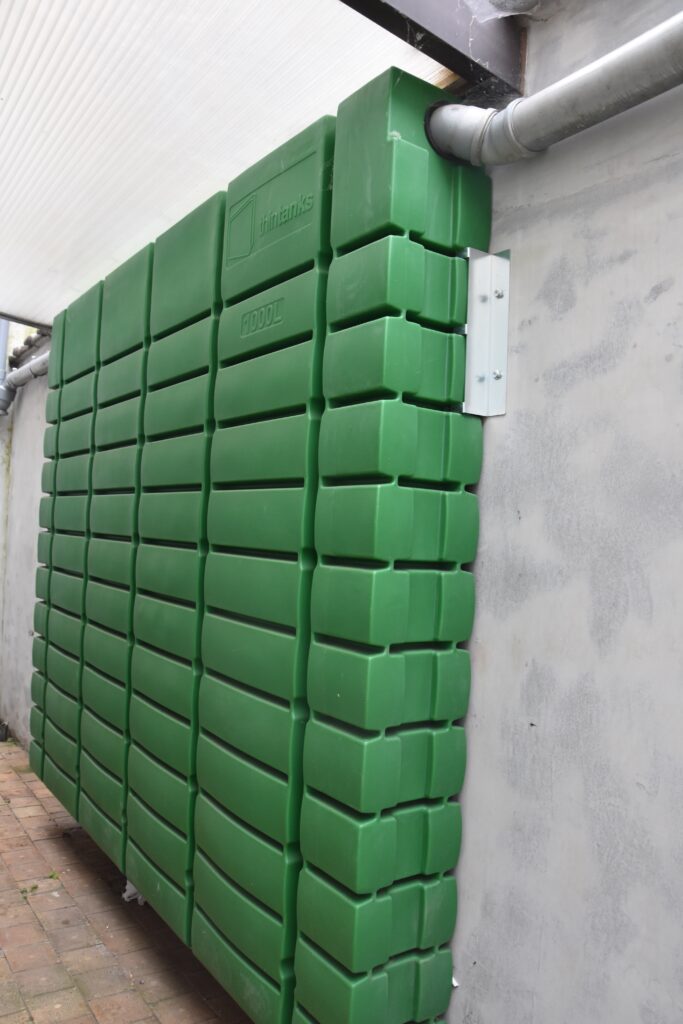
The Autour de Marguerite neighbourhood collective supports initiatives that promote the environment and biodiversity.
As part of this, in 2024, it asked the owner of Rue du Tocsin 1 for permission to install a rainwater harvesting tank (1,000 litres) in their courtyard.
The tank was purchased with the help of the City of Brussels. The tap is accessible from the outside so that there is no need to enter the courtyard. The particularly dry spring and summer of 2025 have already demonstrated the usefulness of collecting rainwater to water the thirsty planters on Rue du Tocsin and Rue Jenneval.
The collective continues its activities in the vegetable garden/orchard in Square Marguerite. However, it remains cautious about its future commitments, given that the new majority in the City Council is slow to adopt budgets to support associations (May 2025).
A mysterious device in Ambiorix and Gutenberg squares
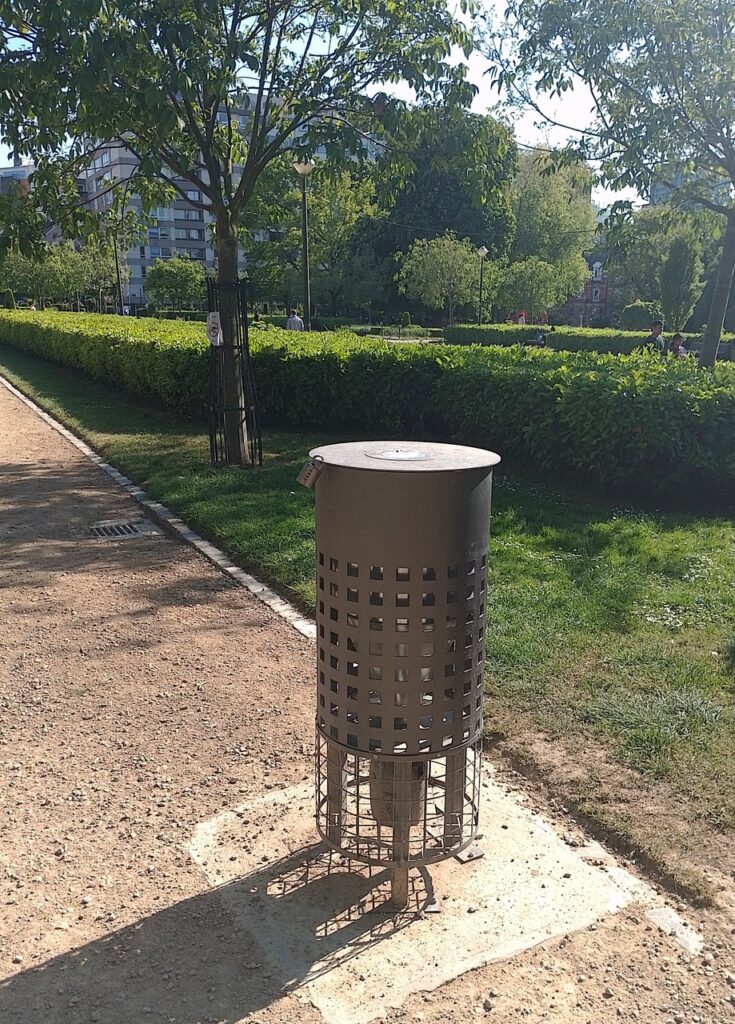
The City of Brussels has installed contraceptive seed dispensers for pigeons.
Developed by the Italian company ACME and under the supervision of Vets For City Pigeons, they dispense nicarbazin-coated corn kernels every morning.
This anti-parasitic agent, used in poultry farming, has the side effect of reversibly sterilising eggs. The quantity of seeds distributed is proportional to the pigeon population present (approximately 100 to 200 individuals here).
The corn is consumed very quickly by the pigeons, so there is no leaching of the product into the soil. The pigeons prevent other birds (crows, wood pigeons, etc.) from approaching. The corn kernels are too large for passerines, which cannot swallow them.
Furthermore, it has been calculated that a dog or cat would have to consume 5 to 6 kilos of grain to feel any effects.
The dispensers are refilled every fortnight by street cleaners (public roads) and gardeners (green spaces).
For further information:
https://www.bruxelles.be/pigeons (with video of feeding)
https://www.vetsforcitypigeons.com/fr
Chirping on Ambiorix Square
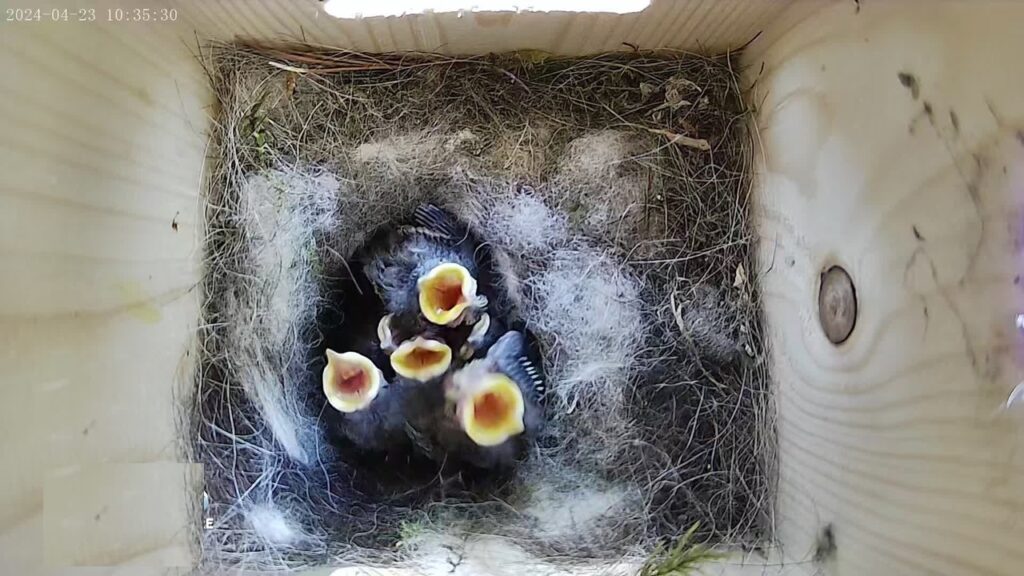
In autumn 2023, the Autour de Marguerite neighbourhood collective entrusted a connected birdhouse to the community centre team.
This is a partnership with the Jardin Extraordinaire, which provides technical assistance when necessary.
The nesting box was adopted by a pair of great tits in spring 2024. Two broods followed one after the other. In spring 2025, the birds quickly signed a new lease. The first brood has already flown the nest (May 2025). After being cleaned, the nesting box is once again operational and ready to welcome a new family.
Access to the images is restricted for privacy reasons because the microphone allows conversations in the vicinity to be heard.
The community centre shares news via the local social network Hoplr. It is also possible to visit the site to see how the brooding is progressing. This is what the children from the local schools have done.
https://www.lesmaisonsdequartier.brussels/fr/maison-de-quartier/maison-de-quartier-ambiorix
Hurray, the Pavi’On has opened its doors!
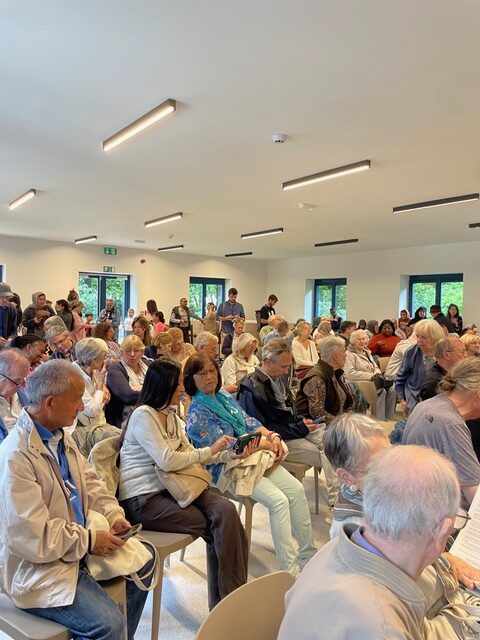
More than four years after the fire, the ‘Pavi’On’ (the new name for the former Pavillon Vanaudenhove in the Parc du Cinquantenaire) has reopened its doors.
The City of Brussels has signed a long-term lease with the Region and has beautifully restored and renovated the pavilion. Two beautiful rooms, a magnificent bar and, soon, projection equipment will be installed there.
The City wants the Pavi’On to become a place where all associations can meet. It is possible to make proposals for its use. Feel free to give free rein to your creativity – theatre, cinema, exhibitions. If your association is looking for a nice place in this magnificent park, contact pavion@lmdq.brussels. It is managed by the Maisons de Quartier.
Although residents have long been asking for public toilets at the Cinquantenaire and the GAQ had suggested making the Pavi’On toilets accessible to all, this issue remains unresolved.
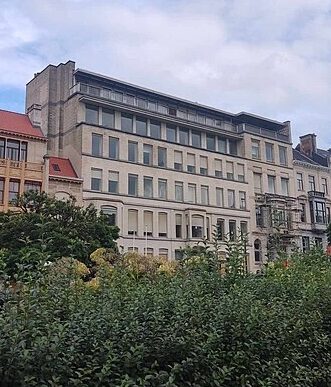
Avenue Palmerston 12
Unoccupied for eight years, this building, which used to house a European Commission crèche, became an ‘innovative art house’ in September 2024.
With a temporary contract until April 2026, 90 artists have been able to create 52 creative workshops. They organise one-off events and one major exhibition per year. They have promised to keep the GAQ informed of their schedule. More info: https://www.pali-pali.com/2024/10/whitewood-treves-palmerston/
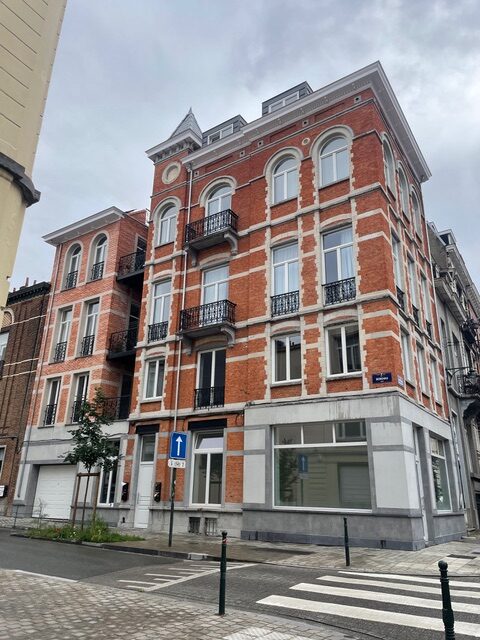
A fine example of renovation and filling a ‘gap’
This beautifully renovated building is located on the corner of Rue Bordiau and Rue des Confédérés.
A year ago, on the Rue Bordiau side, there was only a garage and therefore what is known in urban planning as a ‘gap’. Over the months, we saw a building go up that we thought was an urban planning aberration, but the finished product pleasantly surprised us. Congratulations to the owner for this successful development.
Asian hornets: a silent threat that needs to be better understood
In recent years, Belgium – like many European countries – has been facing the arrival and rapid proliferation of the Asian hornet (Vespa velutina).
Native to Southeast Asia, this insect was accidentally introduced into Europe in the early 2000s. It spread rapidly, thanks in particular to its incredible ability to adapt. Today, it is well established in all regions of Belgium.
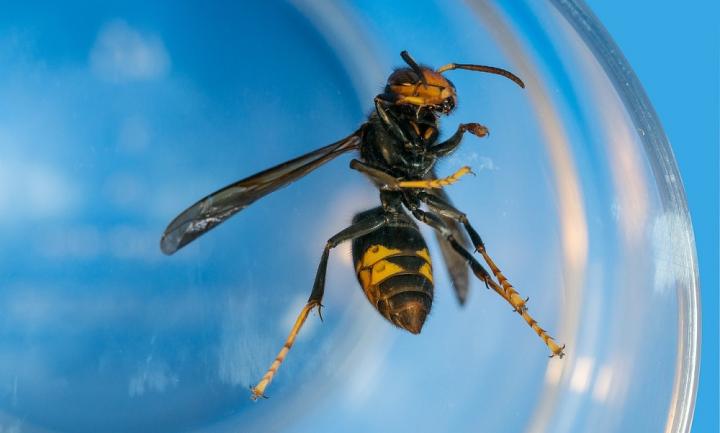
The Asian hornet is a large black insect with yellow tips on its legs and an orange band on its abdomen (not to be confused with the European hornet, which is larger and more orange in colour). It is no more aggressive towards humans than an ordinary wasp, unless you get too close to its nest. However, the proliferation of nests and their low height increase the risk of accidents, especially for gardeners.
Why is its presence a problem?
The real danger posed by the Asian hornet does not directly concern humans, but biodiversity:
• A threat to bees: The Asian hornet is a formidable predator of domestic and wild bees. It can decimate a hive in a matter of days, posing a serious threat to pollination and local honey production. A single hornet colony can consume thousands of bees in a single season.
• An imbalance for ecosystems: by attacking many species of insects (159 species according to recent information), it disrupts local food chains. Its rapid proliferation leaves little room for natural predators or competitors. An average Asian hornet nest consumes 11.3 kg of insects per year, while a large nest can consume 22.6 kg! This leads to fewer adult (reproductive) insects, which threatens local biodiversity, including in the Brussels region.
• A risk to humans: even though the Asian hornet is not particularly aggressive, it can sting in groups when approached near its nest. These stings can be very painful and dangerous for people with allergies, potentially requiring emergency hospitalisation.
What can be done?
The fight against the Asian hornet must be collective, coordinated and environmentally friendly. The City of Brussels has launched initiatives to limit the presence and spread of the Asian hornet within its territory. You can find all the information you need on the website https://www.bruxelles.be/frelons-asiatiques.
Here are some useful tips:
• Report nests: The City needs your help! If you spot a nest (often spherical and large), never try to destroy it yourself, but report it via the ObsIdentify reporting platform or the observations.be website. You can also join one of the ‘Vespa Hunters’ groups on Facebook, organised by municipality:
- Vespa Hunter 1020 : https://www.facebook.com/groups/814059480430098?locale=fr_FR
- Vespa Hunter 1120 : https://www.facebook.com/groups/1133352664169382?locale=fr_FR
- Vespa Hunter 1000 : https://www.facebook.com/groups/1952854801737819?locale=fr_FR
- Vespa Hunter 1130 : https://www.facebook.com/groups/336964925335565?locale=fr_FR
- Observe without panicking: A single hornet in your garden does not necessarily mean that there is a nest nearby. Take a photo if possible and use online tools to identify it.
- Protect pollinators: Avoid using non-targeted insecticides, which can kill bees, bumblebees and butterflies. Promote local honey plants to support biodiversity.
- Queen trapping campaigns: In early spring, Asian hornet queens emerge from hibernation to found new colonies. This is when it is possible to trap these queens before they build a primary nest. So-called ‘selective’ traps can be used, often in the form of bottles or baited devices.
However, these traps must be used with caution. If poorly placed or designed, they can accidentally capture many species of beneficial insects, such as bees, bumblebees, or butterflies—a phenomenon known as bycatch. For this reason, it is strongly recommended that you seek training or advice from beekeeping or naturalist associations before installing them. More selective models and specific baits are available, but their effectiveness also depends on the right timing and location. For more information, visit the ‘Comité F’ website at https://tybou.eu/wordpress/fa/a-propos/.
A challenge for our times
The Asian hornet is a symptom of our globalised world: an unintentionally introduced species that is disrupting our ecological balance. When faced with it, there is no need to panic, but rather to act calmly, with information and solidarity. By learning to recognise it, reporting nests and protecting pollinating insects, we can limit the impact of its presence while preserving biodiversity in our neighbourhoods.
Elena Nalon
Living in the neighbourhood
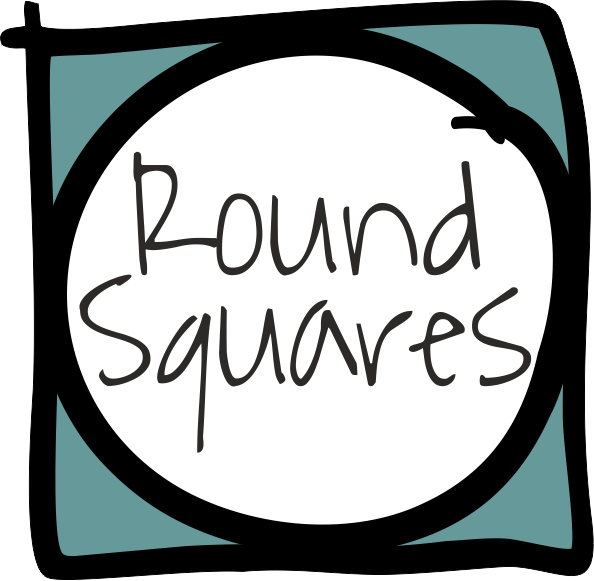
At https://roundsquares.eu one of our members has put up a little site to help new (and old) residents our wonderful neighbourhood settle in, to find their way around, and to get in touch with neighbours – and the GAQ. English-only for now …
A beer like no other

The Dominicans, who live in our neighbourhood at 40 Avenue de la Renaissance, box 24, produce four sacred beers, “Sanctus Dominicus.” You can choose between a Novitius 5.2% wheat beer, a Prior 8.5% lager, a Regens 6.5% amber beer, and a Magister 8.5% dark red-brown triple. Profits from sales support solidarity projects in Belgium and abroad.
For more information, visit https://www.dominicanen.org/fr/a-propos/projets/sanctus-dominicus.
Major Urban Planning Files
Schuman Roundabout
In July 2024, the Council of State rejected the application for suspension of the roundabout work that we had filed in parallel with the annulment application. It ruled that our arguments did not justify suspending the work… which continues. However, we maintained our annulment application, which should be ruled on in approximately a year and a half. By then, the appearance of the site and its access via Avenue de Cortenbergh will have changed considerably…
Newto(w)n, major renovation project at 211 Rue du Noyer
The renovation work began in May 2025. The new use of this building will cause traffic problems for pedestrians, cyclists, buses, taxis, police, ambulances, and traffic in general on Place de Jamblinne de Meux. Not to mention the impact on parking spaces for residents.
However, the GAQ, Collectif 1727, and two private individuals have filed two appeals. The first appeal to the Council of State against the planning permission and the second for cancellation against the environmental permit. The introduction or issuance of permits takes place just before the school holidays. This method undermines the possibilities for residents to react. Financial contributions help us to support our legal actions and to keep you informed. They are therefore, always welcome (Account No. – BE47 5230 8050 0880 – Collectif Opale-Opaal).
The One, Rue Jacques de Lalaing 40
The umpteenth planning permit has been issued for this tower, which was built on the former Crowne Hotel on Rue de la Loi. Early on, two appeals were filed against the project, resulting in the cancellation of both permits. In the meantime, the legal basis on which these permit applications were submitted has changed, and the “Shared Vision for the European Quarter” (https://gaq.be/wp-content/uploads/2022/03/QE_debat-public220223-FR.pdf) now serves as a guide for future real estate projects.
Currently, together with the AQL (Association Quartier Léopold) and the Tervueren-Montgomery Committee, the GAQ is considering the next strategies to definitively put an end to the cycle of permit applications and their issuance, which systematically circumvents legal administrative tools.
Leaselex, Rue de Loi 91-105
Following the “carousel” of permits granted and revoked, the GAQ, in collaboration with the AQL and IEB (Inter-Environnement Bruxelles), has decided to participate in the appeal against the new planning permission granted in the “Leaselex” / EU conference center case.
Îlot (=block) 130 (Rue de la Loi and surrounding areas)
After several twists and turns involving permits requested, granted, and canceled, particularly within the framework of the definitively abandoned PAD Loi (Plan d’Aménagement Plan for the Development of Urban Planning), this enormous complex of buildings along Rue de la Loi, along Chaussée d’Etterbeek and up Rue Joseph II, is now one of the twenty or so buildings purchased by the Belgian State from the European Union. It will be completely remodeled by Cityforward, through Whitewood, and will comprise 25% housing, 5% shops and services, and 70% offices. This project was presented at the monthly GAQ meeting on May 13th. You can find more details here (https://bma.brussels/en/cityforward/).
A stroll along the old streets of our neighborhoods
Whether you live in the Léopold district or the Squares district, both established during the 19th century when the old city walls of Brussels had become the boulevards we still know today, older history awaits you around street corners.
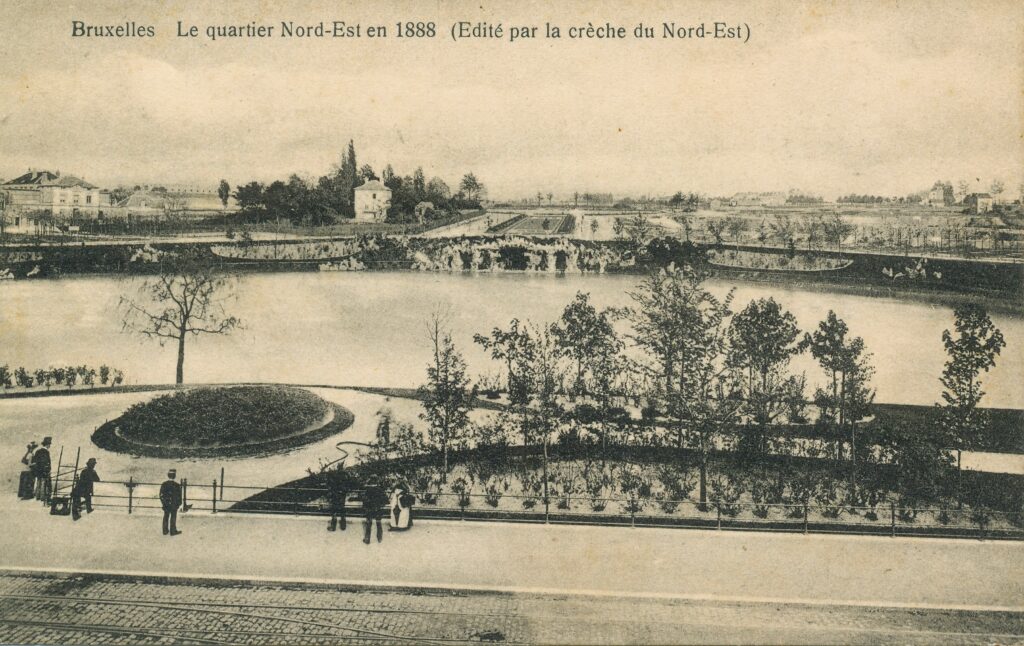
In 1770, the Ferraris map shows “empty” urban areas between the villages of Sint Joos ten Node and Etterbeke. It was here, on the private initiative of Ferdinand de Meeus, governor of the Société Générale, who entrusted the plans to the architect Tilman-François Suys, that the Quartier Léopold was born in 1837. Located in the exact extension of the lateral axes of the Parc Royal and supported by the first King of the Belgians, this residential district, worthy of a capital city, with its amenities such as the Saint-Joseph Church, the Concert Noble ballroom, the Quartier Léopold train station, and its zoo (now the park), welcomed a wealthy and business population.
In 1855, the Rue de la Loi, which forms its western boundary, was extended towards the parade ground (now the Cinquantenaire), and the roundabout was created. The Chaussée de Wavre and Chaussée de Cortenbergh marked the area where the Squares district would be established from 1870 onwards, according to the plans of city engineer Théophyle de Jamblinne de Meux, which were taken up and developed by architect Gédéon Bordiau from 1875 onwards.
However, old roads already existed in this promenade and agricultural area: the Chaussée de Louvain, of course, the Rue du Noyer (which provided access to the Rue de Linthout and the homonymous woods), the Rue Keyser (now Rue Charles Quint), and the Chaussée d’Etterbeek, which ran alongside the Maelbeek stream. Around the “Ter Noye” pond (now Square Louise-Marie), much larger than it is today, the residence of Cardinal Granvelle, the Château des Deux-Tours, and the hydraulic mill that supplied the city with water have also left their mark on the toponymy.
But most of the street names date back to April-May 1877 (see the municipal bulletin of the City of Brussels) and are wonderful history lessons for young Belgium. Thus, the “Old Belgians,” namely the Eburones (Ambiorix), the Franks (Clovis, Charles Martel, and Charlemagne), and the Nervii (Boduognat), are found near the squares, which also honor the Belgian Revolution of 1830 (the English “Palmerston”, the “Brabançonne”, composed by Van Campenhout with lyrics by Jenneval). Further along, the old Rue Keyser still refers to Emperor Charles V, as well as the Battle of Pavia (against Francis I), his Abdication (1855), and his aunt and guardian, Margaret of Austria, in the eponymous square.
Liberal circles of the time did not fail to honor the tragic episode of the “Compromise of the Nobles” of 1566, a plea for religious freedom against the Inquisition of Philip II, with Margaret of Parma, the streets of Cardinal (Granvelle), Luther, Calvin, Inquisition, Confederates, (William) the Silent, and Patriots. Because Charles de Berlaymont called them “Beggars,” they chose the “Écuelle” and the “Besace” as their insignia. Brederode and Lamoral d’Egmont, who already had a street elsewhere, are honored by the battles of Gravelines and Saint-Quentin.
The medievalists on the commission that created the street names also proposed the “Tocsin,” the “Beffroy,” the “Étandard,” and the “Carousel.” Nostalgics of the Austrian Habsburgs had already wanted to honor Maria Theresa and Joseph II closer to the suburb of Louvain in 1860. Scientists pleaded for Archimedes, Isaac Newton, Benjamin Franklin, founding Father but also scientist (electricity), the inventor Robert Fulton (first commercial steamboat, the Nautilus), the mathematician Simon Stévin, the cartographers Abraham Ortelius and Mercator [the street never existed].
Further along the Avenue de la Renaissance, we find artists from this period and later, such as Veronese, Titian, Correggio, Michelangelo, Leonardo da Vinci, [Van der Goes], Hobbema, Van Ostade, Rembrandt, Leys, Wappers, and Murillo.
Contemporary artists, for their part, are honoured by sculptures placed in Square Ambiorix and Avenue Palmerston: thus, from top to bottom, Jacques de Lalaing, with The Barbarian Element, Ornate Civilization, Organized Society (1896-8), Victor Rousseau and his monument to Max Waller (1914), Constantin Meunier with The Horse at the Watering Hole (1899-1901) and Jef Lambeau, The Mad Song (1899-1902), which made almost as much headlines as his monumental sculpture Human Passions installed in the Horta Pavilion in the Parc du Cinquantenaire in 1989.
Sophie Wittemans
Europe in our neighbourhood: Gulliver in Lilliput?
In 1957, when the question of the headquarters of the European Economic Community arose, Belgium proposed the Heysel site, which would become vacant after the World Expo. However, several cities were candidates, and none was unanimously accepted.
It fell to Belgium to house the first EEC officials and alphabetically it ensured the first half of the rotating presidency in January 1958. The former Ministry of the Economy (Rue Belliard) was urgently requisitioned, and an option was taken on a building under construction for an insurance company (avenue de la Joyeuse Entrée).
In December 1958, the Belgian government made a crucial decision for our neighbourhood. Realizing that the deadlock over the choice of its final headquarters was likely to persist, he decreed the expropriation of the Berlaymont nuns’ school and the construction of a building capable of accommodating 3,000 civil servants and, underground, their 2,000 cars.
As new member states joined and new powers were acquired, the needs of the European institutions continued to grow over the following decades. These needs were met by the conversion of residential spaces into offices and, above all, the haphazard construction of buildings that private developers were sure to be able to lease to the institutions.
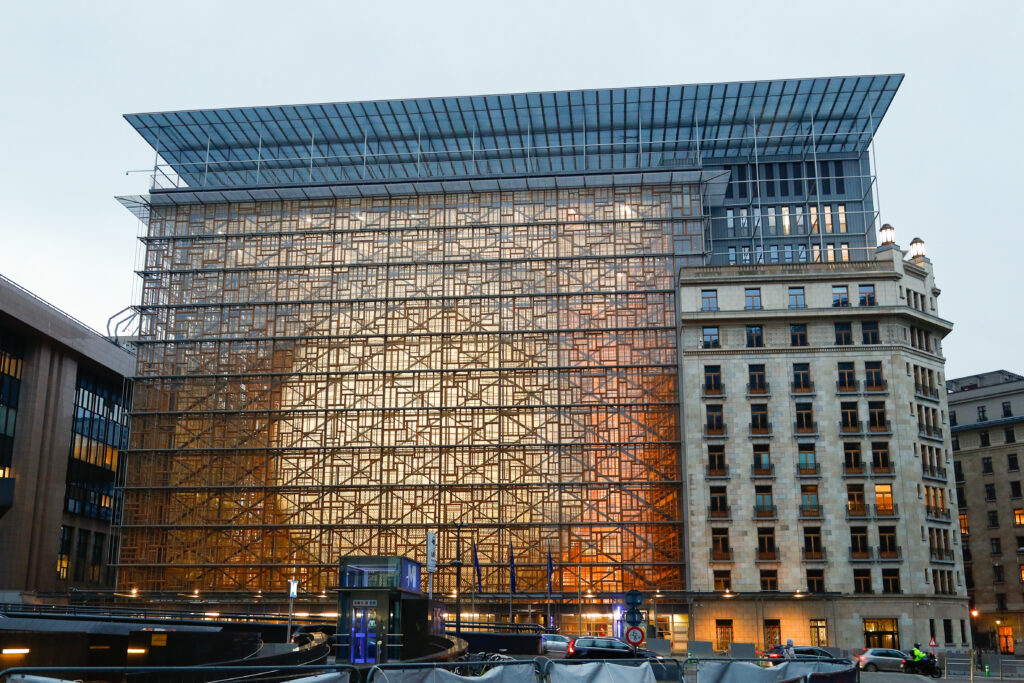
An institutional behemoth representing hundreds of millions of citizens landing in a residential neighbourhood is a bit like Gulliver setting up shop in Lilliput. It also guaranteed incessant construction, demonstrations of all kinds, siren concerts, and helicopter flights.
But it also offers public transport and a level of cleanliness and safety that many Brussels neighbourhoods’ envy. And above all, thanks to our parks and, of course, the GAQ, it offers a quality of life that, frankly, we would be remiss to complain about.
Philippe Van Parijs
GAQ’s traditional neighbourhood party and flea market
At Ambiorix Square, Sunday, September 14, from 8:30 a.m. to 3:00 p.m.
The program includes a flea market, music and activities for children (face painting, circus school), free small bike repairs, food and drinks (including a food truck), and the usual aperitif for the flea market participants.
Conditions for participating in the flea market:
• Register as soon as possible on the GAQ website www.gaq.be (after 09/10/2025, a space costs more and is no longer guaranteed);
• Only used items from attic spaces may be exhibited and sold;
• Priority is given to residents of the European Quarter, but residents of other municipalities may also request a space.
Confirmation of your registration and a map showing your space will be sent to you by email after 09/10/2025.
Would you like to help us on this day? Contact us at fetes@gaq.be
Footnotes
[1] L’IBSA is l’Institut bruxellois de statistique et d’analyse
(1).https://www.who.int/news-room/feature-stories/detail/air-pollution–the-invisible-health-threat
(2) https://www.eea.europa.eu/publications/harm-to-human-health-from -air-pollution
(3) Air Quality in Europe, European Environmental Agency, https://www.eea.europa.eu/en/analysis/publications/air-quality-in-europe-2018
(4) Andrieux J., Eggen M., Bouland C., “État des connaissances sur les liens entre environnement et santé en Région de Bruxelles-Capitale”, Centre de Recherche en
Santé environnementale et Santé au Travail, 2020.
(5) Institut national d’assurance maladie-invalidité (INAMI); calculs Observatoire de la Santé et du Social deBruxelles, OBS 0327
